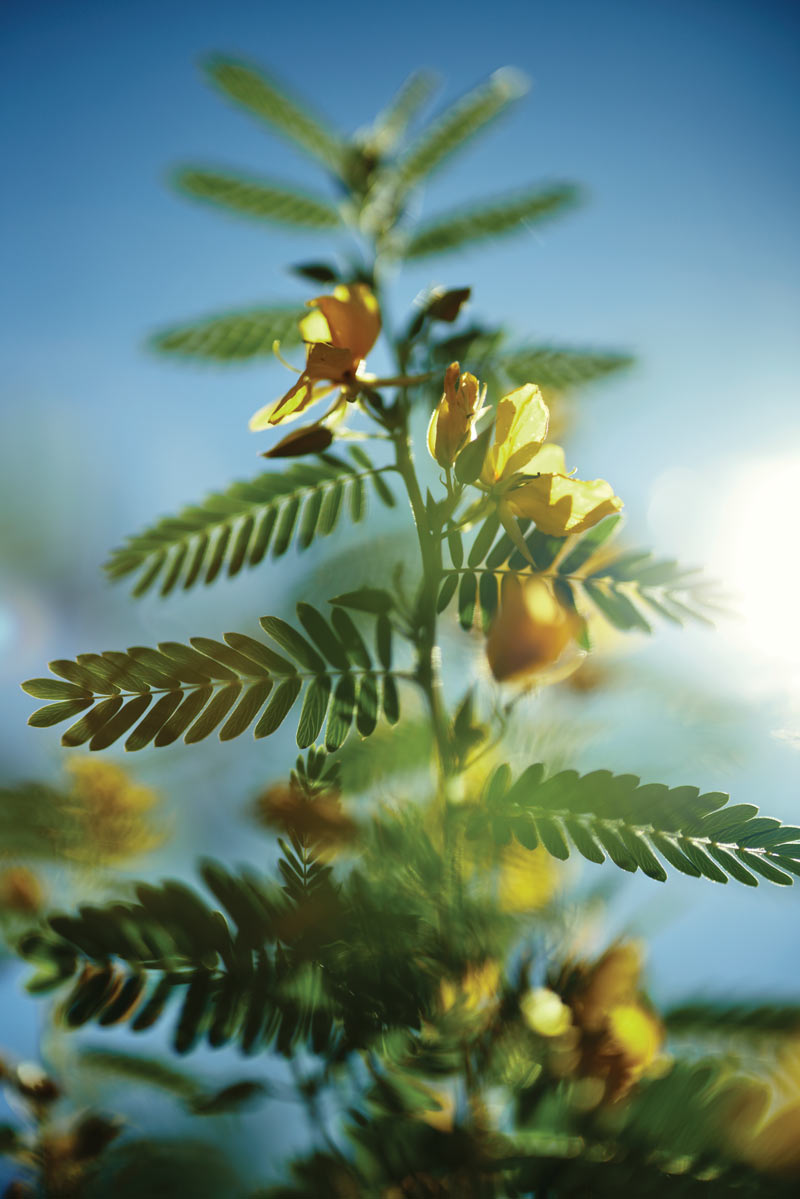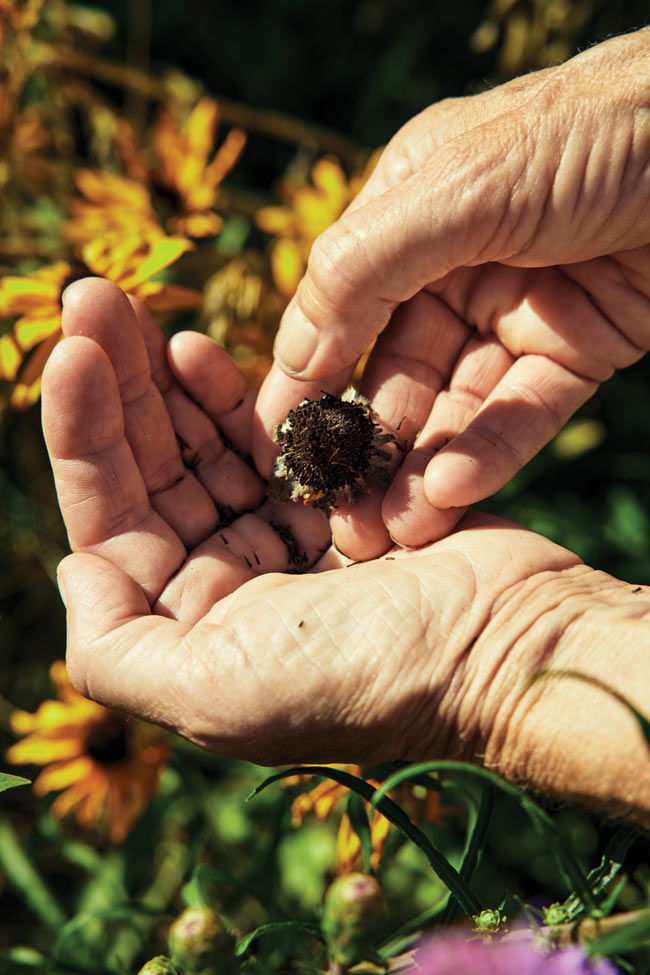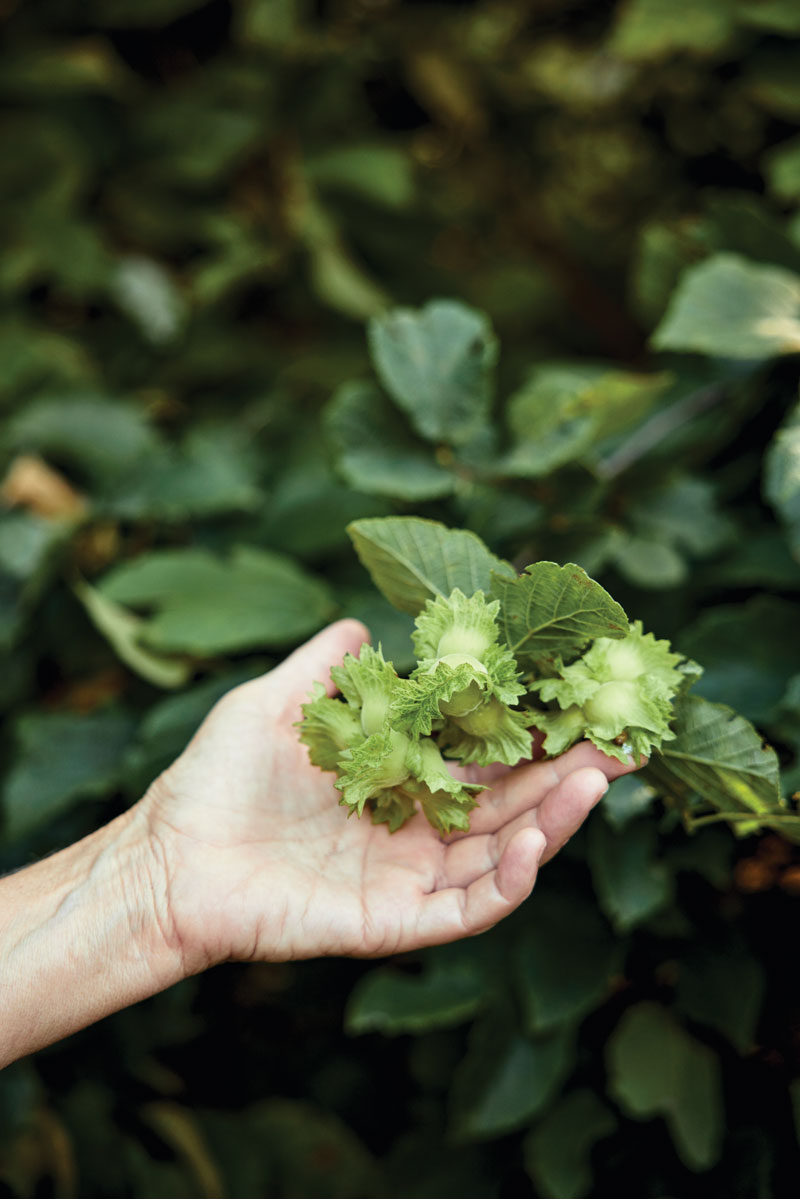By Peter Andrey Smith
Photographed by Michael D. Wilson
From our January 2023 issue
Heavy-duty pickups roared past Heather McCargo’s Prius as she pulled onto the shoulder of Route 11A, in Springvale. It was a cool, clear July day, and the 62-year-old founder of the nonprofit Wild Seed Project stepped out to wait for the dozen or so field-trippers she’d come to guide through a forested preserve called the Harvey Butler Rhododendron Sanctuary. As they gathered, another pair of visitors strode out of the woods, chatting, one of them referring to the place as “a secret garden.” McCargo was quick to set the record straight — the Butler Sanctuary is no garden. “Those aren’t planted,” she told everyone. Indeed, she said, the parcel contains some of the only rhododendrons in Maine that were not deliberately grown. It’s what biologists call a refugium, a relic population that clawed its way north after the last ice age, isolated from its relatives flourishing in the hills of southern Appalachia. “That is the native, wild, big-leaf rhododendron!” McCargo said, her voice peaking in an excitable pitch. “It’s stunning!”
An hour later, she’d led her crew to the preserve’s namesake stand, a patch of lanky shrubs with shiny, dark, evergreen leaves and clusters of fragrant white flowers. “Rhododendron maximum,” McCargo said, reverently. She explained that most garden-variety rhododendrons, the ones decorating suburban lawns, have been cross-bred with Asian species to create hybrids that blossom in every color under the sun. “The hybrid ones don’t support our fauna the way these do,” she said, pointing to a flower just beginning to unfurl, filled with bumblebees. “We should be planting these in our gardens.”


McCargo established the Wild Seed Project in 2014 to teach people to appreciate and grow native plant species, helping to restore some of New England’s lost biodiversity. Initially, the organization comprised only McCargo, a working board, and a small cadre of volunteers, collecting and selling seeds from plants often written off as weeds — joe-pye weed, milkweed, jewelweed — mailing packets from McCargo’s home in Portland’s West End. In her backyard, McCargo planted more than 80 species of trees and shrubs, a demonstration plot with which she attracted curious gardeners and arborists — in the hopes of radicalizing them.
Today, WSP has a staff of eight, an office in North Yarmouth, a nascent horticultural center in Cape Elizabeth, and some 2,000 dues-paying members, who get access to garden tours and Q&As, discounts on seeds, and more. Through its online store, the group offers seeds for more than 90 plant species native to the Northeast. It sold some 6,000 packets in 2019, roughly doubled that the first year of the pandemic, then doubled it again the next year. In 2021, a long, admiring story in the New York Times brought WSP national attention, calling its mission “urgent.” That same year, McCargo stepped down from the group’s helm, handing off day-to-day duties to a new executive director. These days, she sits on WSP’s board, leads walks and workshops and presentations, gives interviews, and spends a lot of time doing what she loves most — simply walking in the woods.
The rapid growth of the Wild Seed Project coincided with a broader war on lawns gaining traction across the country. Lawns in the U.S. cover a land mass about the size of Iowa, accounting for as much as half of all residential water consumption and a quarter of the use of several popular herbicides. Gas-powered lawn and garden equipment puts an estimated 20 million tons of carbon dioxide into the atmosphere each year, and the emissions footprint of nitrogen-heavy lawn fertilizers is as bad or worse. Across the country, particularly in the parched West, cities and towns have started mandating the removal of turf grass and incentivizing permaculture, and more-naturalistic lawn alternatives have even begun catching on in New England, as the region slogs through years of severe drought.
Out in the Butler Sanctuary, as McCargo led her group around the rhododendron patch, she squatted down to show off a little woodland wildflower: Trillium undulatum. Commonly called painted trillium, it had three pale petals with a blush of crimson at their center. Ants typically disperse trillium seed, McCargo said, attracted by a nutrient-rich crest atop each seed. But the insects, she explained, rarely carry the seed more than 20 feet — which, as it happens, is the average width of a two-lane road. Wild Seed Project’s deceptively simple mission — plant seeds, mostly natives, just about anywhere — is a response to such habitat fragmentation and destruction, which has displaced native plants like painted trillium and kept it from regaining a foothold, making landscapes less biodiverse and less resilient to a changing climate. “It doesn’t have to be a shopping mall or a road — if you have a lawn, they can’t get across it,” McCargo said. “Humans put up all these obstacles.”
McCargo spent nearly 35 years working in sustainable horticulture, including five as a head propagator for the Massachusetts-based Native Plant Trust, before founding the Wild Seed Project. In the ’90s, she moved to Brooksville, on the Blue Hill peninsula, where, among other things, she did landscape design and taught agricultural arts at Blue Hill’s Bay School. In 2011, she and her family — her husband, Brian McNiff, a wind-power consultant, and their son and daughter — pulled up stakes for a stint in Barcelona. During their year abroad, McCargo was blown away by the ubiquity of balcony gardens, but she couldn’t help wondering why everything looked the same as back home. “All the urban plants are the same cultivars now,” she said. “Anywhere in the Mediterranean, in California, and probably in South Africa and Australia, you see the same urban plants.” Where others just saw pretty flowers, McCargo saw a mass-produced product flown in by a horticultural industry hooked on nasty, unnecessary chemicals. “I remember thinking then, ‘Okay, most of the world’s people live in the cities. If we can’t get urban people getting nature, then forget it,’” she says.



Back in Maine, having traded Brooksville for Portland, McCargo recognized that organizations like Maine Audubon and The Nature Conservancy did a great job promoting the value of native plants, but she felt people were still sometimes left on their own when it came to getting plants in the ground. She wanted WSP to both educate and facilitate. McCargo gave presentations warning against buying natives from nurseries that pillage plants from the wild (digging up and repotting plants in a garden can deplete or destroy wild populations). She preached against cultivars selectively bred to have double flowers or other visually appealing traits, a process that disrupts the natural reproductive cycle and can prevent plants from making viable seeds. And along with its educational programming, WSP offered what few other vendors do: seeds ethically collected, by hand, free of chemical fertilizers and pesticides widely used in the horticultural trade. Members grew plants and donated their seeds, which WSP put on sale every October. McCargo led seed-collecting workshops, showing, for example, how to cut dried flower heads off fall wildflowers like goldenrod and coneflower, then deposit them in paper bags.
She also convinced wary gardeners to abandon old seasonal routines: WSP discourages raking or blowing autumn leaves, for instance, which are nature’s mulch (“Leave the Leaves!” declares one of the group’s yard signs). It urges gardeners to rethink planting season, publishing an illustrated guide to “Autumn and Winter Seed Sowing in Nine Easy Steps,” as planting seeds in trays and containers outdoors between November and January mimics the natural cycle of freezing and thawing and is a prerequisite for some seeds to germinate.
McCargo recruited ecologists and landscape designers to write for a membership magazine and published how-to booklets on growing plants suited to practically any soil condition. Whether in a backyard, a window box, a parking lot, or a hellstrip (that’s gardener lingo for the barren gap between sidewalk and street), WSP urges people to plant rugged natives that can thrive even with minimal nutrients, sunlight, or water. Those flowers can then go to seed, sowing themselves and establishing gardens that thrive in perpetuity.
Sexual reproduction perpetuates genetic diversity, potentially giving species like cardinal flower a leg up adapting to changing environments.
The Wild Seed Project started selling seedlings a few years back, but McCargo remains a devoted defender of seeds. “I grow everything from seed,” she says. “I’m for sexual reproduction. It’s critical to keep native plants sexually active.”
McCargo had the sex talk with me one afternoon last August, sitting in her backyard, a double plot ringed with pagoda dogwoods, with flowers spilling out from gardens and hundreds of baby perennials in pots throughout the yard. She had just noticed some activity near one of her pots: a hummingbird hovered at a shockingly red flower — Lobelia cardinalis, a cardinal flower — dipping its tongue inside the plant’s tubular, two-lipped blossoms to collect sweet nectar. The stamens essentially feather-dust the hummingbird’s head with pollen, so that, as the bird moves on, it pollinates the next flower.
As the hummingbird flew off, McCargo made the case for sexual plant reproduction, which is something of a lost art in the commercial horticulture trade. The cardinal flower in her garden came from a seed — it’s the so-called “straight species,” meaning the plant evolved from hundreds of years of sexual reproduction. By contrast, most nurseries offer hybrids, crosses between two species; some sell Lobelia with names like Vulcan Red and Starship Deep Rose. Seeds from a hybrid don’t grow true to type, however — that is, they don’t look exactly like their parents — and so breeders rely on forms of asexual (or vegetative) propagation, such as cutting or grafting to ensure they’ll get the same genes and the same ornamental characteristics.
Asexual reproduction creates genetic clones, but McCargo champions sexual reproduction because it perpetuates genetic diversity, potentially giving a species like cardinal flowers a leg up adapting to changing environments. McCargo also points out that while hybrid Lobelia might look the part, they’re a poor imitation — an example of how some cultivars can shortchange pollinators. A researcher she knows from Vermont went out every morning for three years to collect nectar from two groups of Lobelia. She found that the hybrids produced only 20 percent as much nectar as the straight species, suggesting that birds would have to work harder to find food. “So you take a hummingbird, which is already stressed because we ruined their world,” McCargo told me. “Then they find a flower, but it’s like an empty treat.”



The mantra at the heart of McCargo’s mission is that it’s time to rethink what makes landscapes beautiful. If you’re planting based only on aesthetics, she and her WSP colleagues suggest, you’ve overlooked the value to pollinators, to microorganisms in the soil, and to ecological communities — both present and future. McCargo also promotes a new school of ecological thinking about what a “native” plant might be, making room for plants that have had no historical presence but are likely to thrive in landscapes altered by climate change. She’s an advocate for “assisted migration,” planting species that are native to nearby regions but may not naturally migrate fast enough as climate change causes ecosystems to shift. The wild rhododendrons from the Butler Sanctuary are an example, a species considered rare in New England, but flourishing farther south, that might never work its way northward without help — even as Maine’s climate comes increasingly to resemble that of the present-day mid-Atlantic. Part of WSP’s mission is “building climate resiliency, one seed at a time,” and Rhododendron maximum is one of several species on its recommended plant list that’s predominantly or entirely found in regions south or west of Maine.
“The climate is simply changing too fast,” McCargo told me. “Many species have no hope of migrating.” Once established, though, these species stand a chance of weathering warmer temps and the intensification of hydrological cycles, which likely means wetter wet spells followed by comparatively drier ones. “You’re planting them,” McCargo said, “so that they’ll be here in a hundred years.”
A few weeks after I sat in McCargo’s yard, the Wild Seed Project staff gathered with several volunteers at Turkey Hill Farm, a conservation property stewarded by the Cape Elizabeth Land Trust. Most everyone wheeled garden carts full of seedlings across a brown, drought-stricken field, setting up for the annual plant sale. Programs director Anna Fialkoff wandered among the pots and trays, doing an ID check, making sure shade-loving species had ended up under a grove of trees. “There are some white wood asters,” she said, pointing out a scatter of small, daisy-like flowers. “There are a couple of different species of shade-loving goldenrods.” Other plants were lined up in the sun, grouped by species, atop a blanket of black landscaping cloth.
“All hands on deck today,” said executive director Andrea Berry, who was hired when McCargo stepped down in 2021. WSP has since doubled its staff size as well as its membership. To date, the organization estimates some 1.8 million native plants have been grown from seeds it has distributed. Objectives before 2030 include reaching a quarter of all Mainers with WSP educational content, getting a quarter of Maine’s land-conservation organizations to prioritize native-plant diversity and abundance, and persuading the Maine Department of Transportation to rethink management of roadsides and medians, which are mowed into de facto lawn but could instead support wildflower meadows.

This year’s plant sale marked a major milestone in WSP’s maturation, the first public event at its future Native Seed Center. At Turkey Hill, the organization plans to put up a greenhouse and establish permanent gardens, facilitating seed collection and helping meet their goal of making 10 times as much seed available.
Berry, a former engagement director with the philanthropic fund Maine Initiatives, is still learning the basics of IDing many native species. But she’s committed to growing WSP’s membership beyond its core audience of baby boomers and crunchy, organic-foodie types. The organization hopes to place its planting and growing guides in public libraries and schools. They’ve discussed bilingual publications and events tailored to renters looking to rewild their window planters or front stoops. WSP recently installed several demonstration gardens, including one filled with wild strawberries and asters and native lupines at Freeport’s Maine Beer Company. One of Berry’s dream partners is the Maine State Prison’s farm-and-garden project, since formerly incarcerated people often find work in the landscaping trade. A specialized knowledge in native plants, she explained, might make those with criminal records more employable, help meet the demand for ecological landscapers, and be part of a wholesale vision for “racial justice, social justice, and economic justice work.”
“My strategy is, how do we help people find their entry point?” she told me. “Is it because you really care about birds that you want native plants? Is it because you don’t ever want to mow again? Is it because you’re really into foraging and wild edibles? Is it because you care deeply about climate change? Or is it your gardening aesthetic? There are, like, a million other reasons to get excited and engaged with native plants.”
As the WSP staff spent hours moving and arranging plants at Turkey Hill, one person who wasn’t among them was the group’s founder. It was the first time since her organization’s inception, eight years ago, that McCargo wasn’t there to help schlep plants around before the big sale, and this was a conscious choice. McCargo knows that the maturation of any nonprofit requires its founder to move on.
At one point, as the sun bore down, everyone gathered for a quick break, forming a loose circle in the shade. The conversation turned to what McCargo might be up to. Someone imagined her at home, smushing bunchberries, pulping the fleshy, red fruits in order to clean their seeds. Another saw her in her backyard, admiring her beloved baby dogwoods or breaking sticks and piling them up for the birds. Berry thought McCargo might be out collecting. “She just wants to frolic through a field,” she said, “with a paper bag and a pair of scissors.”




